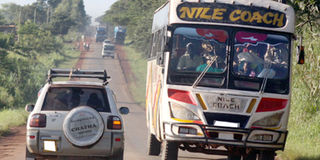What happened to the speed governors?

Speed governors were introduced to check road accidents, especially caused by bus and truck drivers. In 2012, they were withdrawn and replaced with speed guns. PHOTOS ISMAIL KEZAALA
In a bid to reduce road carnage especially caused by reckless bus and truck drivers on upcountry routes, speed governors were introduced. However, there was uproar among the affected drivers and in 2008, installation of the devices ended. Esther Oluka looks back at what exactly happened, given that accidents are still claiming lives.
I n order to reduce on the number of accidents involving passenger service vehicles, in 2004 the Ministry of works and Transport issued a statutory instrument on speed governors. The speed governors, whose use was implemented by police, were intended to limit the speed of buses and trucks.
However, encountering a number of challenges during the implementation exercise, in 2008 the law officers relaxed on enforcing their use and subsequently speed governors were withdrawn. This was after their use was disregarded by bus and truck drivers. The chairman of Uganda Bus Drivers and Allied Association, Hannington Kiwanuka, says the reason the majority of drivers were not happy with the idea of having speed governors installed in vehicles was because of the irregularities that came at the time they were introduced.
“Those devices had a tendency of spoiling the engines and they were limiting the speed to 80kph. Buses are driven at a faster speed. So, how did police expect us to drive at that rate? ” Kiwanuka wonders. He believes if the speed limit had been stretched to 120kph, then may be, they would have bought the idea of having the speed governors installed. Challenges faced
Dr Steven Kasiima, the commissioner for traffic, says there were various issues that were raised concerning the use of speed governors. “There were complaints that these devices were quite costly to install onto one’s vehicle and also that if the speeds of these vehicles were fixed to particular kilometres per hour, the engine would eventually get affected,” Kasiima explains. The other reason Kasiima gives is most drivers were ignorant on how to use them. Also, there were malicious individuals who were tampering with the devices in order to drive at higher speeds and this would at times cause accidents. Simon Mujuni, a truck driver, is among those who overwhelmingly rejoiced when the use of speed governors was discontinued.
“I hated the way policemen used to harass us to have those devices installed in our vehicles. Some of them would even ask for money in order to let us off the hook,” he explains. Mujuni says the devices were quite costly as well, since they were being sold for more than Shs300,000.
Hated from their introduction
Meanwhile, Lawrence Niwabiine, head of traffic in Kampala, thinks otherwise. He strongly believes that the majority of drivers were against the idea of installing speed governors because they did not want their speed to be limited.
“Drivers normally want to determine their own speed limits while driving and therefore they saw these devices as a huge hindrance to them,” Niwabiine explains. Niwabiine says that as an alternative, police introduced the use of speed guns.
“These are helping us determine the speed of any moving vehicle,” he says. Niwabiine adds: “It also enables police officers capture the other details about the car including the number plate. This kind of information is what enables us follow up and prosecute speeding drivers who do not want to stop when they are told to.”
As much as they are helping to reduce accidents on the road, Niwabiine states they are not 100 per cent effective since they cannot be operated without a police officer holding them.
“They require a police officer to stand by the road side in order to capture the details of the car,” he explains. Niwabiine says that these devices are also quite few in number and therefore some routes are not being monitored. “We are mostly stationed along the Kampala, Malaba and Busia route. Our next focus will be the Kampala, Masaka and Kisoro route,” he states.
Accidents still claiming lives
Niwabiine states that since Uganda is regarded as one of the African countries with the highest rate of road accidents, there is the need for motorists to drive carefully regardless of the fact that speed governors are no longer in use. A global status report on road safety that was released in 2013 indicated that Uganda had 2,954 deaths in 2010 as a result of road accidents. Nigeria had 4,065 while South Africa registered the highest number at 13,768 by 2009.
Safety campaigns
Uganda National Roads Authority (UNRA) is also currently involved in a campaign of sensitising drivers on proper road usage in order to curb down the number of accidents on the roads.
“We are mainly targeting drivers of buses and other heavy vehicles since they happen to be involved in accidents quite very often,” Dan Alinange, the Uganda National Roads Authority (UNRA) says. Alinange says that although the implementation exercise has faced a problem of limited funding, it has not stopped them
It is partly our responsibility to see that we continue reminding these drivers of the dos and don’ts while on the road so as to limit accidents on the road,” Alinange says.
He adds that UNRA has is improving the designs of the roads and widening them from 6.5metres to 11.5metres. A lot more needs to be done, without which Uganda will continue to see many road accidents with a worrying percentage being fatal.




